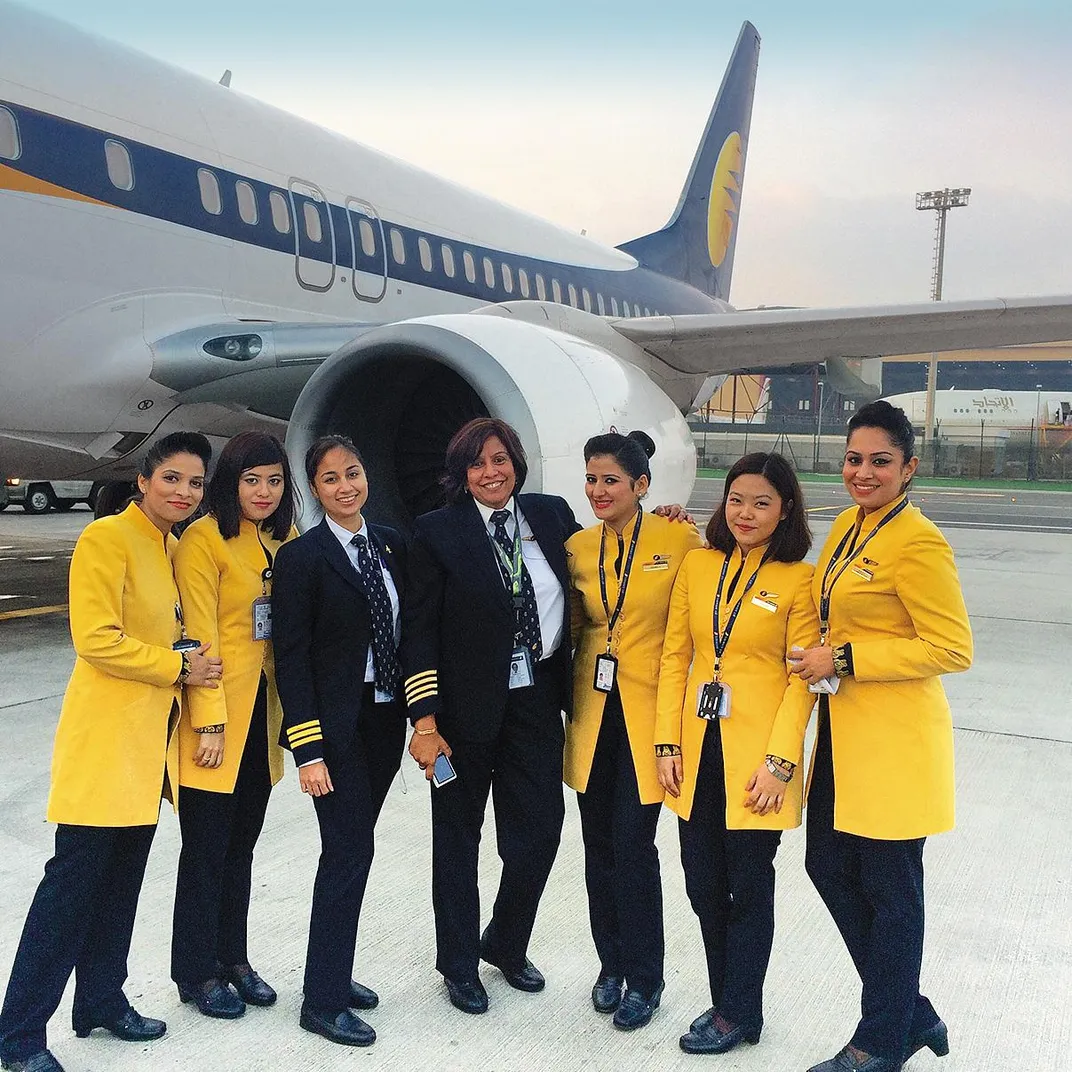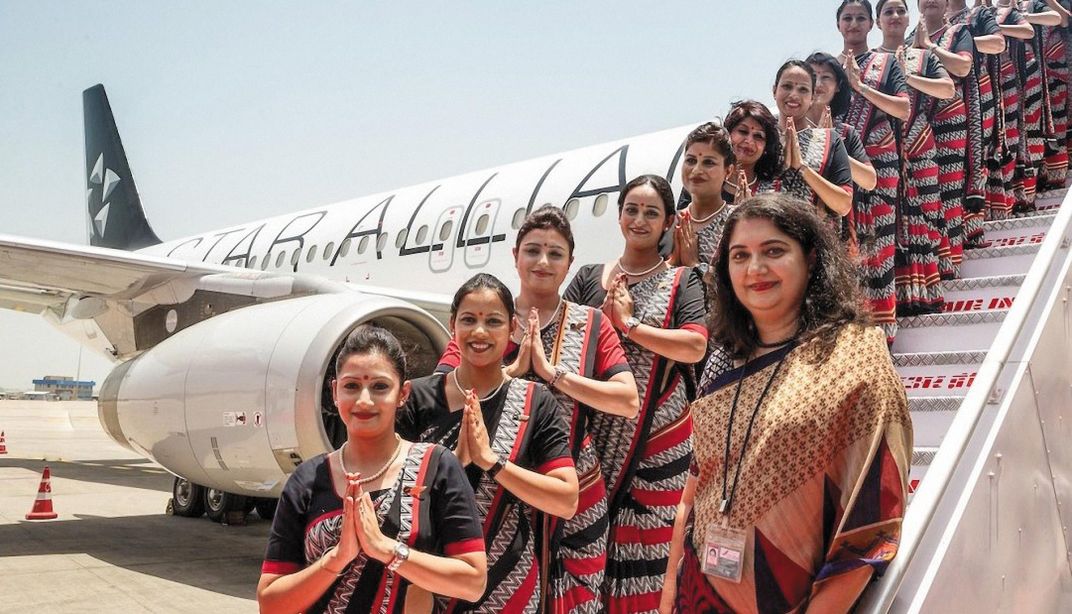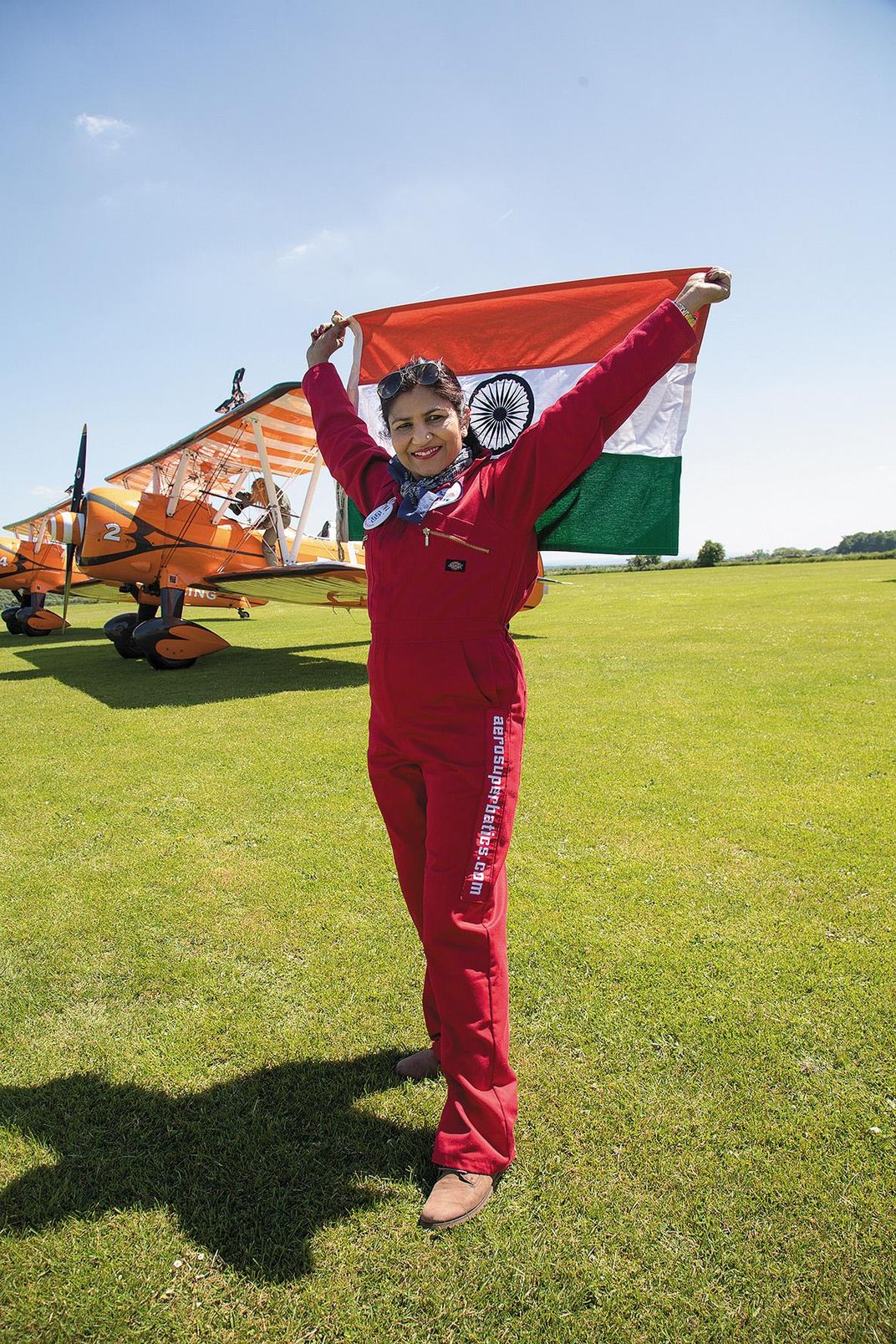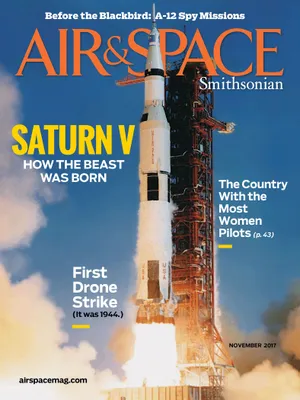The 30,000-Foot Glass Ceiling
Gender equality has a tough climb in India, but climbing is what airline pilots do.
/https://tf-cmsv2-smithsonianmag-media.s3.amazonaws.com/filer/88/aa/88aa4937-0bae-4a9f-b7ec-334e36f38b9e/08b_on2017_harpreetwkshamtasunitacoverapril_live.jpg)
Her young life growing up in Delhi, India wasn’t all about flying. She was a long-legged college high jumper who dreamed of becoming a professional athlete.
Kshamta Bajpai joined the Indian National Cadet Corps (NCC), a volunteer paramilitary group offering skills training without the obligation for full-time military service. She started in the Army Wing, but switched to the Air Wing when she was denied the opportunity to take a coveted mountaineering training course. Bajpai began para-sailing and gliding, getting winched up, controlling the angles as she descended to the fields without an engine, treasuring each opportunity “to feel the air,” she says.
She met the man who’d become her husband when her glider weather-cocked in strong winds and he complimented her—in front of a bunch of men—on her “controlled crash.” Soon after, at age 19, Bajpai wrote to Prime Minister Rajiv Gandhi, pleading for a scholarship to attend Indira Gandhi Rashtriya Uran Akademi (IGRUA), a brand-new national flight academy. To her surprise and to her family’s utter shock, she received a reply inviting her to the prime minister’s office for an interview. Her scholarship request was approved.
Some three decades later, Bajpai, 48, is a senior pilot for Air India and, as of last March, a world record-holder, having co-commanded the first Boeing 777 round-the-world flight with an all-women cockpit and cabin crew. If Rajiv Gandhi were still alive, he would have been pleased: Before he succeeded his mother, Indira Gandhi, as prime minister following her 1984 assassination, he’d been a pilot for Indian Airlines. In office, he had been a strong advocate for women in aviation.
The younger Gandhi was assassinated in 1991, but the technological India now emerging somewhat resembles the one he wanted to build. Sitting with me in San Francisco’s Le Meridien Hotel last March, Commander Bajpai said India has become one of the world’s best places for women to fly.
We’re with four of her colleagues: Commander Sunita Narula, First Officer Indira Singh, First Officer Gunjan Aggarwal, and Harpreet A. De Singh, Air India’s Chief of Flight Safety. De Singh instituted and oversees the airline’s annual all-women cockpit and crew flights. I met them on a stopover during their round-the-world flight in honor of International Women’s Day, as they were in the process of becoming the first all-female Boeing 777 crew to circumnavigate the globe. It was a joyful event for everyone, but doubly so for De Singh, who was the first Air India pilot to break the glass ceiling in the cockpit—nearly 30 years ago, when the airline was hiring only male ex-air force pilots.
All five officers realize the symbolic importance of their endeavor: “Our entire message in these flights is actually to encourage young girls who have dreams of getting into the skies but feel it’s too technical or something only men can do,” De Singh told me. “India is a complex paradox.”
The elements of Indian culture that most Westerners hear about are Bollywood movies, the population explosion, and honor killings. Though the latter gets international attention, people who actually live in India are aware of a far more widespread general sexual harassment of women and girls. But India is also a country of indefatigable aspiration and emerging gender equality, particularly in aviation.
The country leads the world in the training of professional women pilots, producing female fliers at four times the global average, De Singh says. Air India’s pilot force of 1,990 includes 225 women, and that number is ticking up. The India Women Pilot’s Association (IWPA)—De Singh is president—says women now constitute more than 10 percent of all pilots in India; the global average hovers a little under three percent. But according to FAA data obtained and published by Mireille Goyer, founder of Women Of Aviation Worldwide Week, in 2011, those numbers aren’t much higher in the United States. Here, women holding “other than student pilot certificates” account for four to five percent. But these percentages have barely budged since 1980.
According to a study published in the 2014 book Absent Aviators: Gender Issues in Aviation by Deanne Gibbons, a sociologist and member of the Royal Australian Air Force, stagnation in the number of women pilots being trained in Western countries is attributable to several tough-to-overcome factors, including the high costs of learning to fly, as well as the old perception of aviation as dangerous and difficult—a “man’s job,” according to some survey respondents. A U.S. study, by Penny Rafferty Hamilton, a Colorado-based pilot and aviation educator, also found that cost was the most oft-cited barrier for women wanting flight education, followed by “instructor-student communication incompatibility”; instructors leaving flight instruction to take airline or charter service jobs, requiring the flight student to start over with another instructor; and a lack of female mentors.
In India, women are filling 15 to 20 percent of the cadet seats in the nation’s prestigious flight schools, and up to 95 percent are finishing training en route to coveted airline jobs—a market that oscillates between hiring sprees and contraction.
Vinod Kumar “Charly” Verma is the director of the IGRUA, India’s first government-run flight school, established in 1985 in Raebareli, Uttar Pradesh. He says the gender of pilots doesn’t matter; they just have to be good. “We are very quality-conscious,” says Verma. “My personal opinion is that flying is a skill which also requires psychological skills [i.e., readiness] in that your body and mind have to work together. If the girls are a little short, they weigh a little less, we give them cushions to sit on. But in their mental tuning, attitude, there is no difference with the men…. We advertise for boys and girls with the same enthusiasm. We have no bias.”
The people sitting across from me are the proof that training is open to those who have the talent and drive regardless of gender. A generation of aviation leaders is emerging from a country that has no room for complacency.
Commander Bajpai recollects how her first flight instructor, Captain Gunaratnam M. David, shouted at her when she was training on a simulator more than 25 years ago. “I was training with a boy at Air India who was much thinner than me,” said Bajpai. “We were the captain’s first students in Air India, his first experience in training—he was ex-air force. So to start he said to me: ‘You’re a girl, and you’ve just come up. You’ve got to perform at 200 percent to be seen at par with them [men],’ ” she said. “There were some days you’d do well and when you didn’t do so well, the captain would get really riled up. ‘Don’t think that because you’re a girl I can’t sock you! I can sock you just because you’re stronger than him! There is no gender bias here!’ ”
Bajpai savors those words. The captain never made good on the threat, she said. “But when he talked to me like this, I said to myself, ‘I’m in the right place.’ ”
Growing up, Bajpai says, she was the black sheep of her family, but today she has commander written all over her. Tall, soft-spoken, fluent in Hindi, English, and Gharwali—a dialect from her home region outside Delhi—Bajpai still moves like the athlete she was in her college days, striding and bouncing as she walks. Dressed for our meeting in an earth-toned sari and pearls, with a crown of thick white hair, her dark wide eyes framed in big glasses, she remembered that when she first arrived in Jeddah, Saudi Arabia, after piloting an Air India flight, the female Saudi security officers pulled on her sleeves, asking, “Are you real?” She’d just flown an airplane into a country where women cannot get driver’s licenses. And now flying is the family business: Her husband is a gliding instructor, and their 22-year-old son is a pilot with SpiceJet, an Indian carrier.
Her companions make a similarly strong impression. Sunita Narula, also a senior Air India commander, is a 45-year-old mother of two, angular with wavy long hair, and a four-time national yoga champion. She is Air India’s only woman line training captain for its Boeing 777 fleet, responsible for the instruction of other pilots. Indira Singh, 47, an economics graduate from the University of Mumbai, started out as a flight attendant, then trained as a pilot in Lubbock, Texas. Gunjan Aggarwal, a 28-year-old first officer, flew an airplane before she could back the family car out of the driveway.
For some women, the decision to fly is more pragmatic. “Women are opting more and more for commercial pilots licenses to get jobs,” said Captain Saudamini Deshmukh. Now retired from Indian Airlines (which merged with Air India in 2011), Deshmukh in 1988 became the first Indian woman to command a Boeing 737 and then, in 1994, the first to command an Airbus A320. She said that while demand for pilots fluctuates, airlines are continuing to recruit heavily. “India is known for technical expertise on one hand and poverty on the other,” Deshmukh explained to me. “These contrasts go on at all levels. That’s the uniqueness of India.”
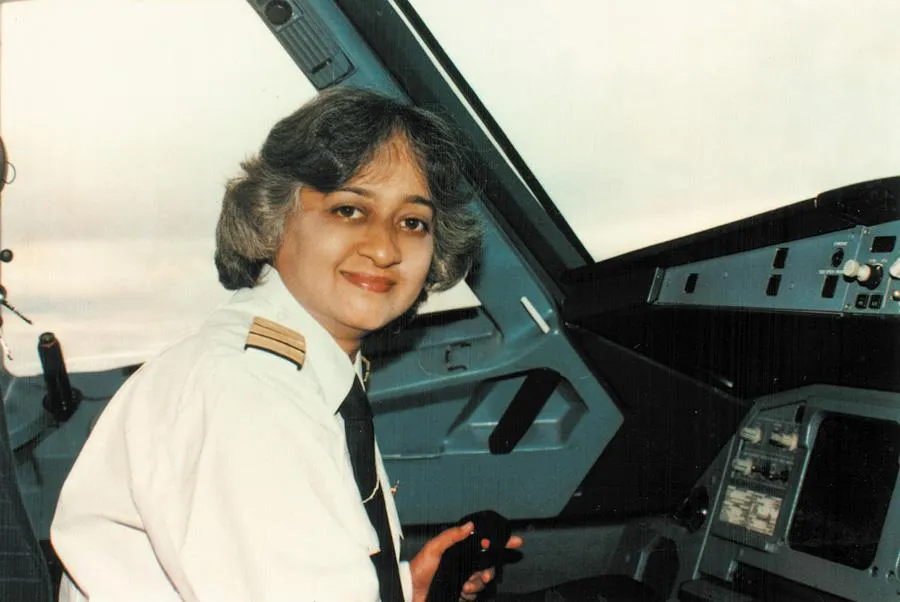
De Singh said that in India, “pedestal complex”—the belief that “women are to be put on a pedestal and worshiped,” rather than allowed to develop their own skills and pursue their own goals—remains entrenched. But a growing middle class is making India more inclusive and competitive.
Breaking into aviation in India is still daunting. None of the five women pilots I interviewed in San Francisco were rich; most of them juggled and borrowed, as did their families, to pay for flight education. Except for Aggarwal, who started with Air India as a 20-year-old flight academy grad, each had a circuitous journey—in Bajpai’s case, six years as a freelance pilot flying a King Air C90A—to their full-time jobs flying for Air India.
“Flying was not a childhood dream for any of us,” Bajpai recalled. “We didn’t know aviation as an avenue we could explore unless we took up the air force, but back then air force didn’t take women pilots.”
In fact, the Indian air force (IAF) began inducting female pilots only in 1993, long after De Singh, Narula, and Bajpai had finished their civil aviation training at IGRUA. According to Pamela Pereira, a 14-year veteran IAF pilot who now serves as a Boeing type captain with private Indian carrier Jet Airways, the early years for women in the air force were uncomfortable. “IAF was training us to find out if we could adapt both to [aviation] work and the armed forces environment,” she recalled. “It was a male bastion. Because we were new, most of the people we worked with didn’t know whether they needed to handle us with kid gloves.” But the women cadets insisted on equal treatment, Pereira said, and soon attitudes changed.
Today, the IAF has recruited and trained roughly 150 female pilots—the first trio of young women fighter pilots was inducted in 2016 for training on the BAE Hawk, a single-engine jet trainer—yet the IAF still denies permanent commissions to women pilots. “Women officers have gone to the courts and won all the other cases except for permanent commissions in the flying branch,” Pereira said. “So we still have bias.”
India is on pace to become the third largest civil aviation market by 2020, and the largest by 2030, despite China’s accelerating growth. In addition to the rapid expansion of airline fleets and infrastructure, the country is loaded with private flying clubs, a big incubator of youthful aviation interest. Grants and loans are available, though government money is tightening, and competition remains fierce for entry into the two big government flight schools, IGRUA and the National Flying Training Institute in Gondia, Maharashta. There are also private aviation schools, some notorious for inflating student flight logs and dispensing private pilot’s licenses a little too readily. However, Indian courts have begun cracking down on unscrupulous training practices. Air India and some of the big domestic airlines—IndiGo, Jet Airways, SpiceJet—say they vet candidates carefully before offering them jet training.
Only about 10 percent of the 1,200 who apply each year make it into IGRUA’s 18-month training academy, according to Verma. Cadets must first pass post-secondary exams with high scores in math, physics, navigation, basic mechanics, and English.
These days, when girls and boys compete for admission to flight school, it’s the girls who do better, according to Ivan Jalaluddin, the senior flight operations inspector in India’s Directorate General of Civil Aviation (DGCA, the Indian equivalent of the Federal Aviation Administration).
“I’ve been a training captain in the airlines for both men and women students,” he said. “There is no official policy in place for women to join flying, but when there are two candidates, there’s a good chance the woman is going to get selected [because] temperamentally, certain natural traits make women better for the job.”
Girls are more procedural, by the books, Jalaluddin continues; they tend to be better at assigning priorities and sticking to them. By contrast, “boys are hardwired to indulge in risky behavior when it’s not called for. When you examine air accidents, for example, [males] have pushed the envelope in an approach when the weather indicates a turn back. Girls stay with the procedures and fly safer.”
**********
The main predictor of success in the cockpit is the ability to focus. But for Commander Sunita Narula, a natural flier who came from a family of modest means, the real challenge was learning English in flight school. She had attended government schools where only Hindi was spoken, right up through university. “I understood [English], but I couldn’t speak it fluently,” she said. At IGRUA, “I used to cry that people had completed their studies in a few hours,” while hers would take much longer because she had to translate so many of the English words and phrases into Hindi, though English proficiency is a requirement for admission. Narula admits now that in her interview, her replies to questions were “not fluent.” She thinks she got in because she was able to demonstrate that she understood even highly technical questions asked of her in English, at one point grabbing a pen and paper and proceeding to draw engine parts for which she had not yet learned the vocabulary.
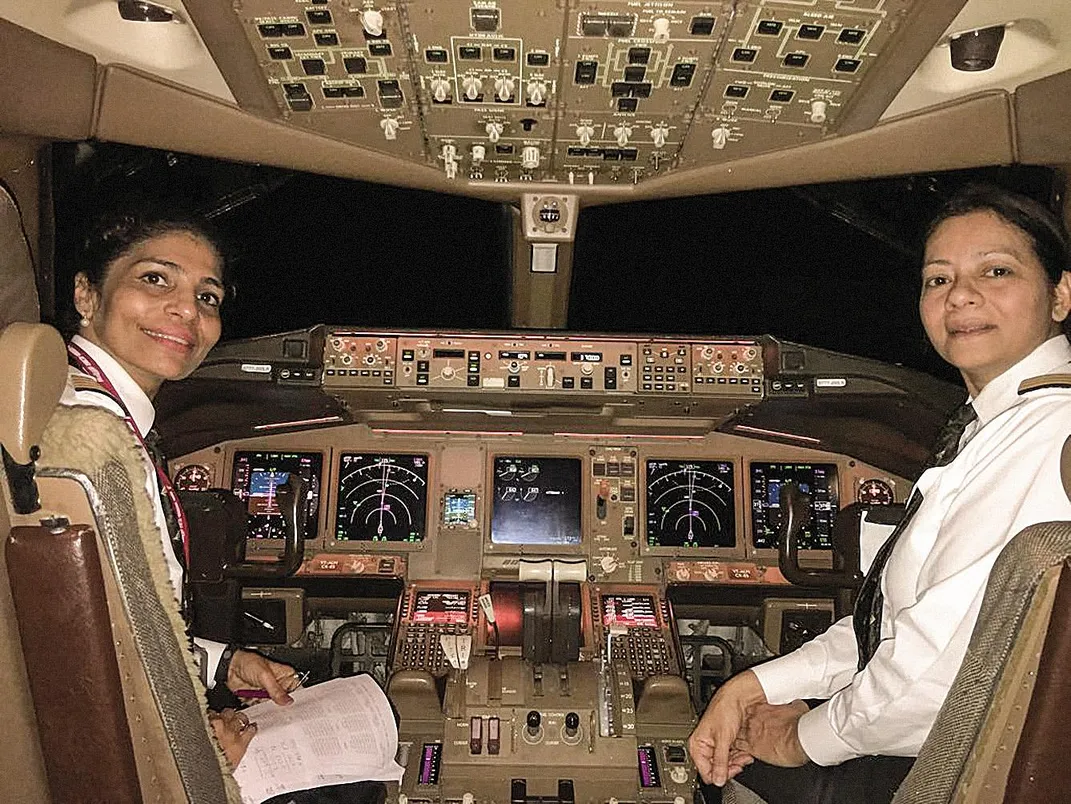
Eventually, Narula mastered English along with mathematics and economics, working as a university lecturer in Karnal, her hometown, before entering the IAF as a flight cadet in January 1994. In addition to flight training, her training included the foot-soldiering basics—marksmanship, wilderness survival. Air India hired her in September, three months before she was due to be commissioned, which would have required her to serve a minimum of five years. Because the job offer came prior to her commissioning, she was able to leave the military by repaying the cost of her training.
“I think flying was destiny for me,” she said. “I belong to a small town in the north of India, 120 kilometers from Delhi. I had just finished my high school exams, and I saw these yellow somethings roaming around in the air”—aircraft that she would later learn to identify as yellow-painted HUL-26 Pushpak trainers. So I asked my mother, ‘Can’t I learn how to do this?’ And she said, ‘Yes.’ ” Having no other pilots in the family, she decided to take up flying as a hobby. “But I fell in love with it and couldn’t think of doing anything else.”
Narula’s family struggled to pay for her flight lessons—her father was an engineer; her mother, a teacher. But she was highly motivated, and as she finished the university courses preparing her to be an economics teacher, her private flying instructor sped to her home on a motor scooter, insisting to her parents, “This girl has to fly!”
Narula eventually won both state and federal scholarships to complete her IGRUA training. “In this society, we are not encouraged to spend money on the girls because the girl is going to get married,” she said, “so what money you give will go to the girl’s husband’s family and not to you.”
Fortunately, her parents were open-minded. “They said to me, ‘What’s stopping us?’ And I have to thank my state for supporting my education and giving me so much.”
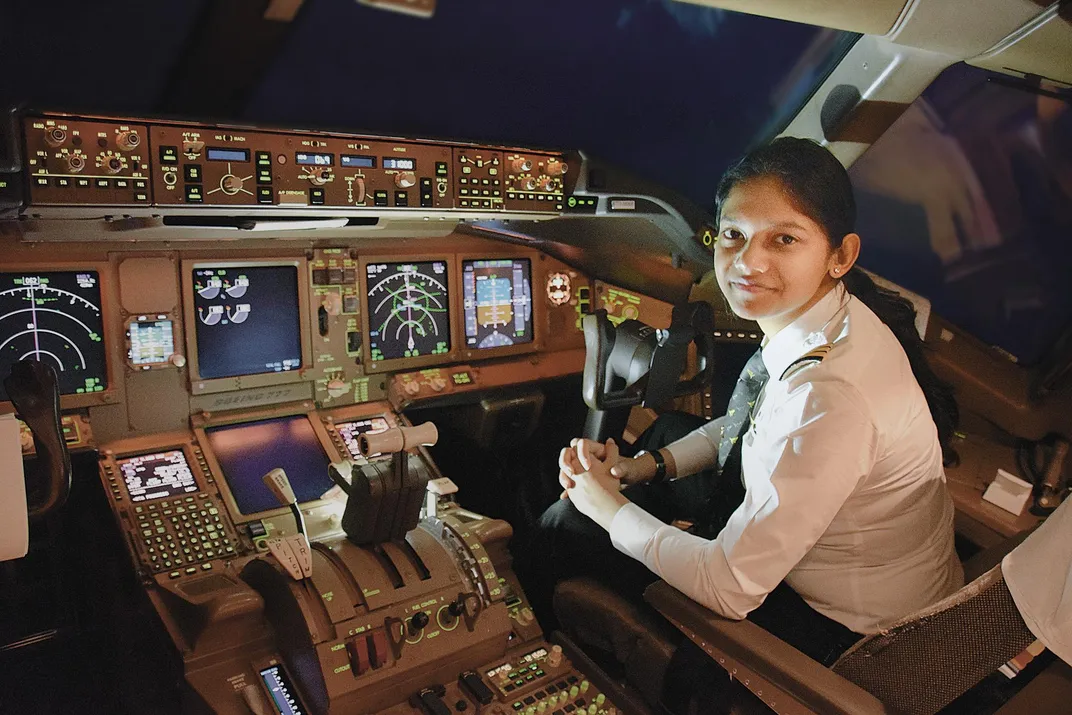
Kshamta Bajpai, who got her own scholarship by appealing in writing to Rajiv Gandhi himself, said her parents and grandparents shared the view that girls should be educated along with boys. “I have three sisters and a brother,” she told me. “My father was a schoolteacher. We were very close to my maternal grandparents, who lived in the small hill town of Tehri, on the banks of the river Ganga [Ganges]. My maternal grandparents were very special people who ran an open house. They were both ‘freedom fighters’ in India’s struggle for independence from the British, and were imprisoned for a time…. My grandfather was a lawyer and my grandmother kept a huge extended family together. She was very liberal and independent in her thinking and actions, ensuring gender equality at a time when India still had deep-seated cultural biases that worked against the girls. I am sure she shaped the thinking of my parents.”
Indira Singh began her career as a flight attendant in Hong Kong for Cathay Pacific, but she wanted more. “My parents thought that I should do computer science instead,” she said. But Singh followed her heart, first nabbing a visa to learn flying at Dulles International Airport near Washington, D.C., where her sister lived, then studying at Flight Tech, an aviation academy in Lubbock, Texas. She completed her commercial ratings there and, licensed by the FAA, returned to India to fly for Raj Airways. She trained for the airline in Munich on a Dornier 328, and when Raj went under, her Dornier experience gave her the entrée to Air India and Airbus 310 training. (Her current assignment is the Boeing 777.)
Singh says that when her parents tried to talk her out of flying, they were thinking only of her employability. “The whole emphasis today among middle class parents is how to improve the child’s life,” she said. Now that she is married and has a daughter of her own, she understands that concern, but she’s never regretted her choice.
Of the women I spoke with, Gunjan Aggarwal had the most direct route to an airline career. As a 12-year-old she looked at the flashing strobes of an airplane in a clear night sky. “I asked my father, ‘Should I become a pilot when I grow up?’ ” she recalled. She left a Delhi engineering school at age 17, applied to IGRUA, and within two years had completed all instrument, multi-engine, and commercial pilot ratings, entering jet training at Air India. “I was the luckiest in my family,” she said. Tuitions for flying at IGRUA had been rising (today’s 18-month tuition runs about $50,000); her parents helped her obtain a loan. “Without thinking about me being a girl or that I would be married off soon, my parents supported me,” Aggarwal recalled. “I wanted to share this because even with limited means and such a huge fee, and with no prior experience in aviation from anyone in my family, my parents didn’t ever say ‘no,’ and that to me is commendable support.”
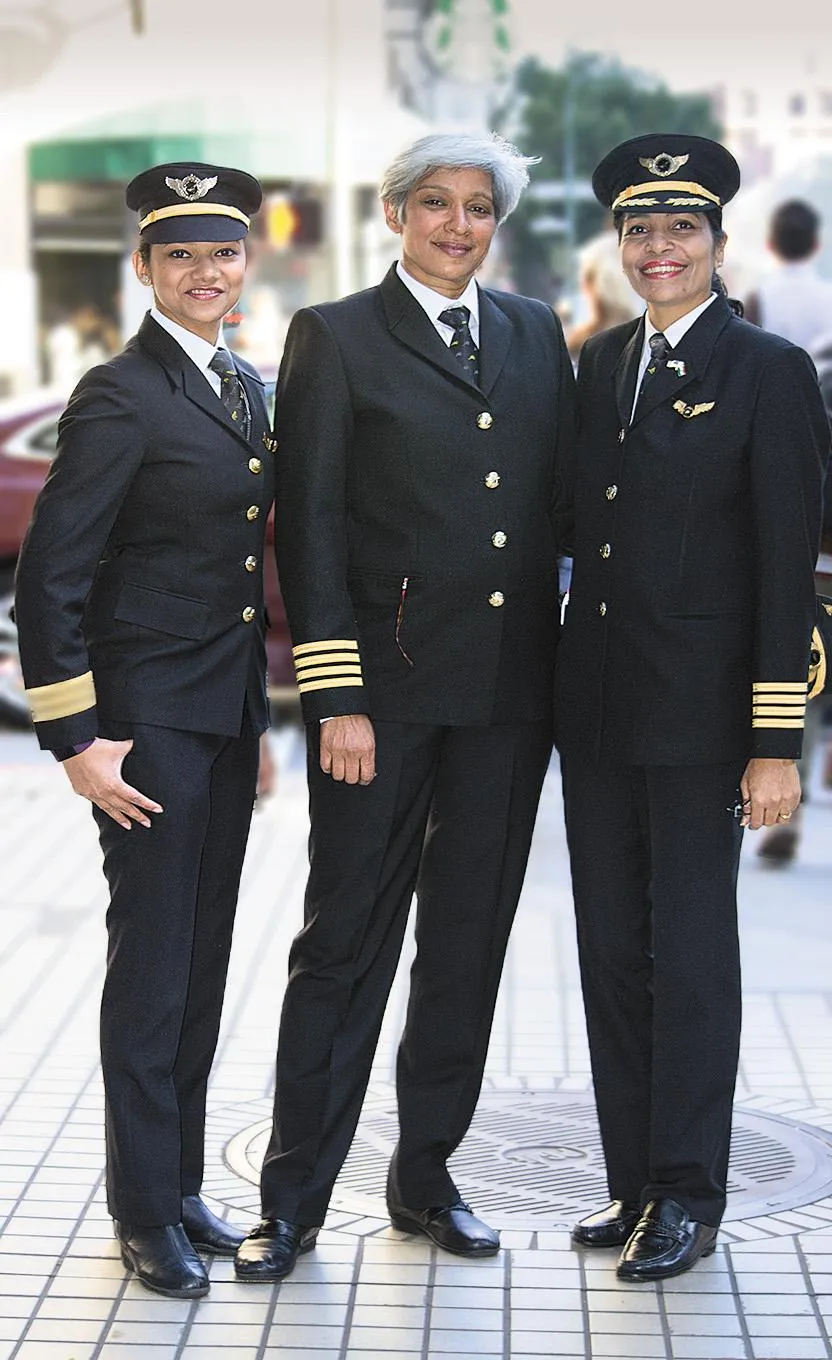
De Singh, Air India’s flight safety chief, probably experienced the toughest journey of all. She attended coed schools at the insistence of her father, an Indian Air Force veteran turned Indian Airlines employee, and completed a university degree in commerce before enrolling at IGRUA. She would have been happy to work for any airline, but her instructor urged her to apply to Air India. “Air India in 1988 mostly had male pilots from the Indian air force, most of them in their 30s and 40s,” she said. “Many of those folks thought they were superior to the other airlines, but IGRUA broke the barrier, and it was the first time Air India hired commercial pilots directly from the academy.”
She was the first woman to break through. “My flight instructor insisted I interview only with Air India, not Indian Airlines [which was known to be more liberal and had already begun to hire women as pilots]. ‘Harpreet, you are meant for Air India,’ he said. ‘Start that tradition there because no one else can do it.’ ”
Air India accepted her. She had already passed a medical exam from the DGCA and was ready to start, but the airline then endorsed a new medical test with an electroencephalogram, or EEG. The brain scan indicated a minute possibility that De Singh might black out at the sight of lightning. She was crestfallen. “I asked them, ‘How could I be permanently unfit to fly when two months ago I was perfectly fit with a DCGA medical license? ” De Singh went back to the DGCA and had the test repeated several times. She obtained EEGs on her own, hoping for a different result. She wrote to medical authorities around the world inquiring about the reliability of the test. But DCGA declined to reverse the decision.
“I wish it had not been public knowledge that I was the first woman pilot selected for Air India,” she said. [Because of that], nobody wanted to take that risk and let me fly.” De Singh left Air India and in 1988 went to New York, re-certifying again for commercial flight and obtaining all her FAA licenses while teaching ground school. But she missed home, and she returned to Air India. She married a fellow Boeing 777 pilot, raised two children, and rose to more powerful positions in customer service, training, and safety. As chief of flight safety, she’s one of the senior executives in the company.
“The important thing about why women in India are taking up professional flying today, especially those who are flying international flights, is that they now have a support structure,” she said. Air India has adopted many family-friendly policies for its pilots, including flexible work schedules and generous parental and sick leave—policies that make it possible for pilots like Narula, who has a 10-year-old and 14-year-old, to do their jobs without sacrificing their commitment to their families.
And once they’re in the cockpit, Bajpai says, gender is as irrelevant as everything else outside the safety of the passengers and crew. Until you’re back on the ground, she says, you no longer think of yourself as a woman or as a man. “You shut the cockpit door, the switch goes off, and you’re a pilot only.”
